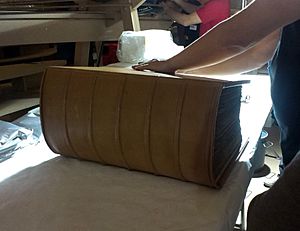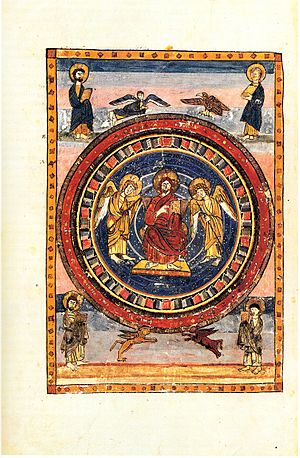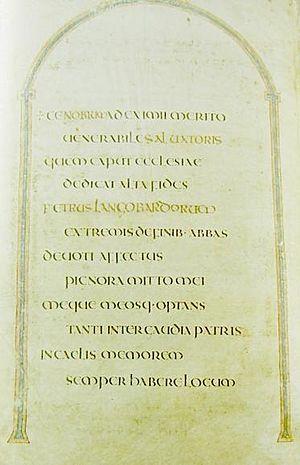Codex Amiatinus facts for kids
The Codex Amiatinus (also known as the Jarrow Codex) is one of the best-preserved copies of the Latin Vulgate version of the Christian Bible. It was made around the year 700 in England, at a Benedictine monastery called Monkwearmouth–Jarrow Abbey. This area is now known as South Tyneside. The Codex was sent to Italy in 716 as a gift for Pope Gregory II.
It was one of three huge Bibles made at Monkwearmouth–Jarrow. It's the earliest complete one-volume Latin Bible that still exists today. It's also the oldest Bible where all the books match the Vulgate texts.
The Codex is named after Monte Amiata in Tuscany, Italy, where it was found in modern times. It was kept at the Abbazia di San Salvatore monastery there. Today, you can find it in Florence at the Biblioteca Medicea Laurenziana.
This book is very important because it's considered the most reliable copy of Jerome's Vulgate text for the New Testament and most of the Old Testament. Some books, like Ezra–Nehemiah, are presented as one continuous book. The same goes for Samuel, Kings, and Chronicles.
What is the Codex Amiatinus?
The Codex Amiatinus is an enormous book! It stands about 19+1⁄4 inches (49 cm) tall, 13+3⁄8 inches (34 cm) wide, and 7 inches (18 cm) thick. It weighs over 75 pounds (34 kg). It's so big and impressive that it fills people with awe.
This special book is an illuminated manuscript. This means it has some beautiful decorations and pictures. It includes two full-page pictures, which are copies of older artworks.
The Codex has 1,040 pages made from strong, smooth vellum. Vellum is a type of parchment made from animal skin. To make all these pages, it would have taken the skins of about 515 cattle! The writing is in large, clear letters called uncial characters. Each page has two columns of text, with 43 or 44 lines in each column. There are no punctuation marks, but the text is arranged in a way that helps readers understand the meaning.
How was the Codex Amiatinus made?
The story of the Codex Amiatinus began in 692. The abbot, Ceolfrith, ordered three copies of the Bible to be made. This was a huge project! The monastery needed more land to raise the 2,000 cattle required for the vellum.
It's believed that Bede, a famous scholar from that time, was involved in putting the Bible together. He might have even helped write some parts.
In 716, Abbot Ceolfrith took one copy, the Codex Amiatinus, on a journey to Rome. It was meant as a gift for Pope Gregory II. Sadly, Ceolfrith died during the trip in France.
The book later appeared in the 800s at the Abbazia di San Salvatore monastery in Monte Amiata, Italy. This is how it got the name "Amiatinus." A list from 1036 at the Abbey described it as an Old and New Testament "written in the hand of the blessed Pope Gregory." It stayed at this monastery until 1786, when it moved to the Laurentian Library in Florence.
For a long time, people thought the Codex was much older and made in Italy. But in 1888, a scholar named Giovanni Battista de Rossi proved that it was connected to the Bibles mentioned by Bede. This showed that the Codex Amiatinus was indeed made in England. Even though this made the Codex about 150 years "younger" than previously thought, it still remains the oldest complete copy of the Vulgate Bible.
The Codex Amiatinus was very important during the Counter-Reformation for Catholics. Later, in the late 1800s and early 1900s, scholars used the Codex Amiatinus as a main source to create new, more accurate versions of the Vulgate Bible.
See also
- List of New Testament Latin manuscripts
- Celt (tool) – a famous mistake in most Vulgates, not found in this copy
- Ceolfrid Bible – likely a piece of one of the other two Bibles ordered by Ceolfrith
- Codex Fuldensis




